Raw plant dyes offer you a natural alternative to synthetic colorants in your handmade soaps. You'll create unique, vibrant hues while supporting sustainable practices and reducing environmental impact. These botanicals, like madder root for pink or turmeric for yellow, can provide potential skin benefits while breaking down safely in ecosystems. By choosing plant-based dyes, you'll avoid petrochemicals and embrace a traditional art that connects you to nature. There's a whole spectrum of botanical possibilities waiting to transform your soap crafting journey.
Environmental Benefits of Plant-Based Soap Dyes
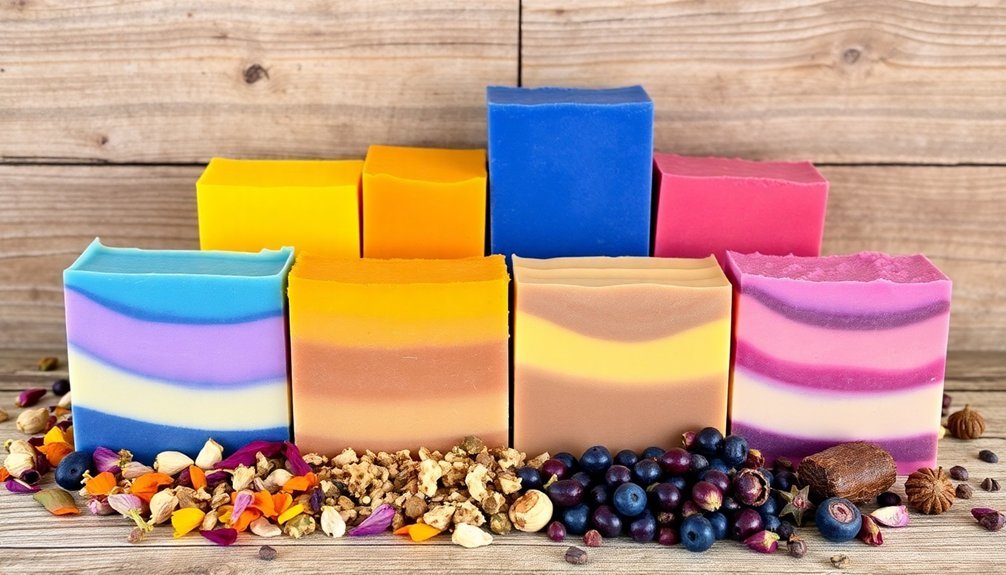
While synthetic dyes continue to dominate the commercial soap industry, plant-based alternatives offer compelling environmental advantages.
When you choose plant-based soap dyes, you're supporting biodegradable solutions that naturally break down without harming ecosystems.
Your choice promotes sustainable agriculture and biodiversity, as farmers cultivate these renewable resources locally. You'll also contribute to reducing water waste, since plant dye production requires less water than synthetic manufacturing processes.
Plant-based dyes promote local farming while using less water than synthetic alternatives, supporting both agricultural sustainability and environmental conservation.
By supporting community-based farming initiatives, you're helping decrease transportation emissions while fostering local economic growth.
The environmental impact of your soap-making choices extends beyond the immediate benefits. You're investing in a sustainable supply chain that doesn't rely on petrochemicals, ensuring that future generations can continue to enjoy natural coloring options without compromising environmental health.
Popular Raw Plants and Their Color Properties
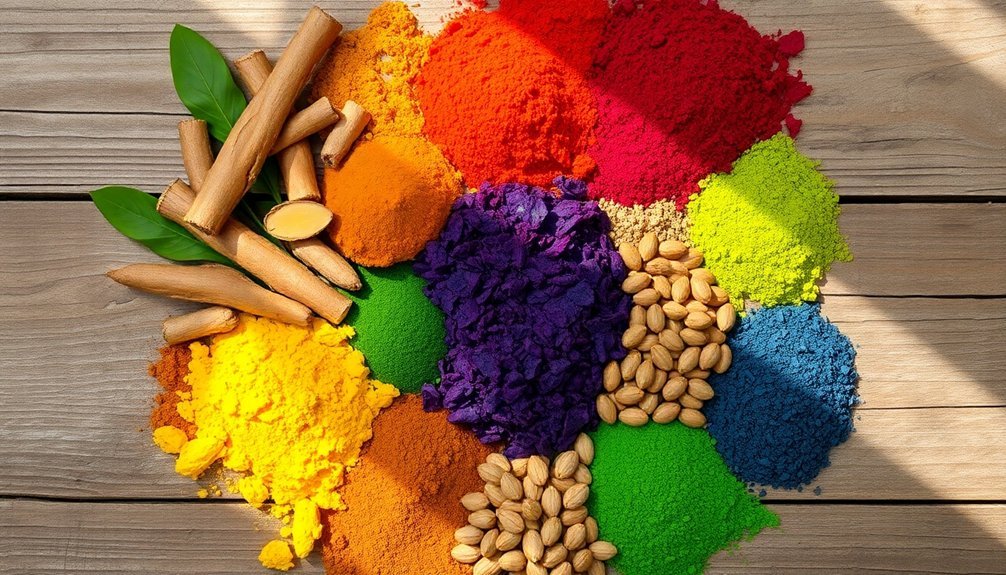
Have you ever wondered what gives natural soaps their stunning rainbow of colors? Raw plant dyes offer an exciting palette of natural colorants that you can easily incorporate into your soap making.
Madder root creates beautiful pink to red shades, while turmeric delivers vibrant yellow hues that also benefit your skin. If you're looking for purple tones, alkanet root is your go-to choice, though you'll need to master its use to avoid unwanted color shifts during saponification.
For a bright orange splash, try annatto seeds from the achiote tree.
Calendula petals are particularly special among natural colorants, as they maintain their lovely yellow shade even in soap's high pH environment.
These soap coloring options prove that nature provides all the color properties you need for creating visually appealing, natural soaps.
Preparation Methods for Natural Colorants
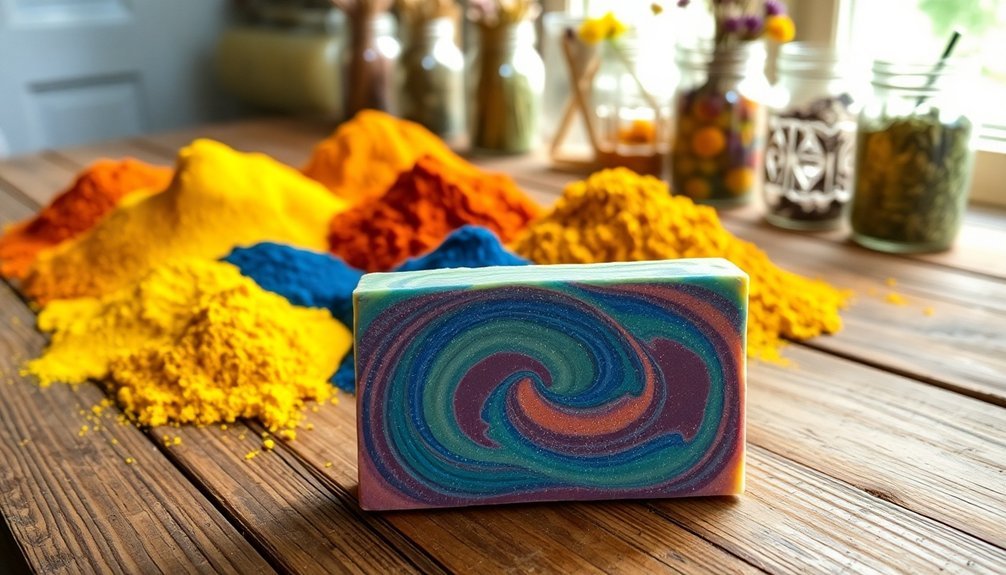
You'll achieve the best results with natural colorants by infusing dried plant materials in oils for several weeks, using a ratio of 1 oz. of plant powder to 15 oz. of oil.
To make the straining process easier, wrap your plant materials in cheesecloth before adding them to the oil.
After the infusion period is complete, you can remove the cheesecloth bundle, leaving you with a beautifully colored oil ready for soap making.
Oil Infusion Best Practices
Because oil infusion serves as a cornerstone technique for natural soap coloring, mastering the proper ratios and methods will greatly impact your results.
You'll need to combine 1 oz. of plant material with 15 oz. of oil for peak color extraction. Choose golden-colored oils as your base to guarantee your natural colorants shine through without interference.
When preparing your cold-process soap, you'll want to use at least 15% infused oil in your total recipe to achieve vibrant color and prevent graying.
While it's tempting to rush the process, allow several weeks to months for your infusion to develop fully.
Adding infused oil to your soap batter, rather than direct plant powders, will give you more consistent and striking results throughout your finished bars.
Straining Raw Plant Matter
After mastering oil infusion techniques, proper straining becomes the next key step in achieving professional-quality natural soap colors.
You'll need to remove all residual particles through straining raw plant matter using either cheesecloth or a fine mesh strainer before adding it to your soap batter.
When working with natural colorants, you'll want to infuse your plant materials for several weeks to extract their vibrant essence.
Use a ratio of 1 ounce of plant powder to 15 ounces of oil for ideal color concentration.
By thoroughly straining your infusion, you'll avoid the pitfalls of unstrained matter, which can create unwanted specks or uneven coloring in your final product.
This careful attention to straining guarantees you'll achieve consistent colors in your cold process soap, resulting in a smooth, professional appearance.
Best Practices for Color Extraction and Application
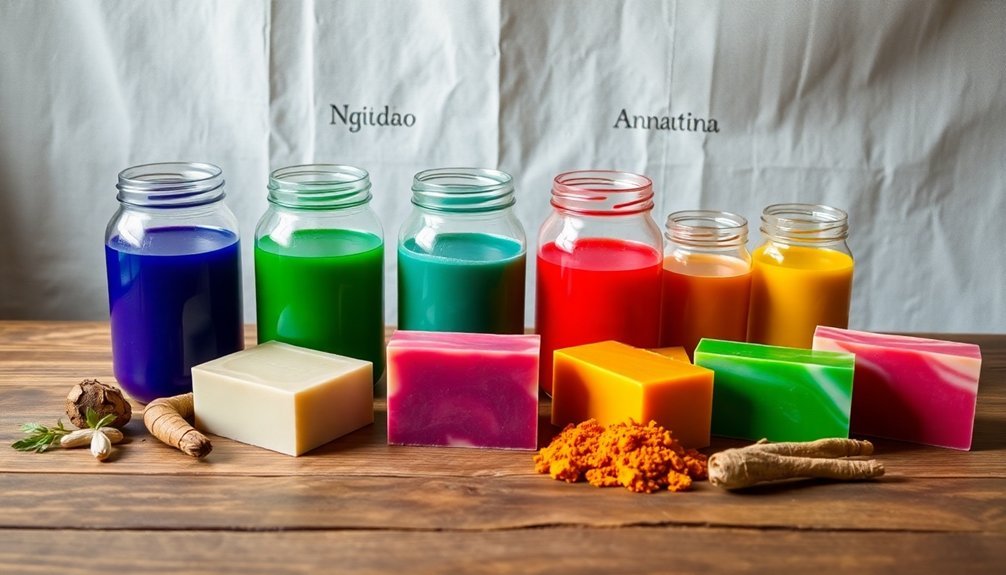
When working with raw plant dyes for soap making, proper extraction and application techniques make all the difference in achieving vibrant, lasting colors. You'll want to infuse your natural colorants in oil for several weeks or use a crock pot to maximize color extraction. For best results, maintain a 1:15 ratio of plant powder to oil, and guarantee your infused oils make up at least 15% of your total soap recipe.
| Process Step | Key Consideration | Best Practice |
|---|---|---|
| Oil Selection | Color Base | Choose light or golden oils |
| Infusion | Time Management | 2-3 weeks or crock pot method |
| Application | pH Monitoring | Test regularly during saponification |
Using light-colored oils is especially vital when working with purple dyes like alkanet. Throughout the soap-making process, you'll need to monitor pH levels carefully, as they can greatly impact color stability.
Combining Plant Dyes for Custom Hues
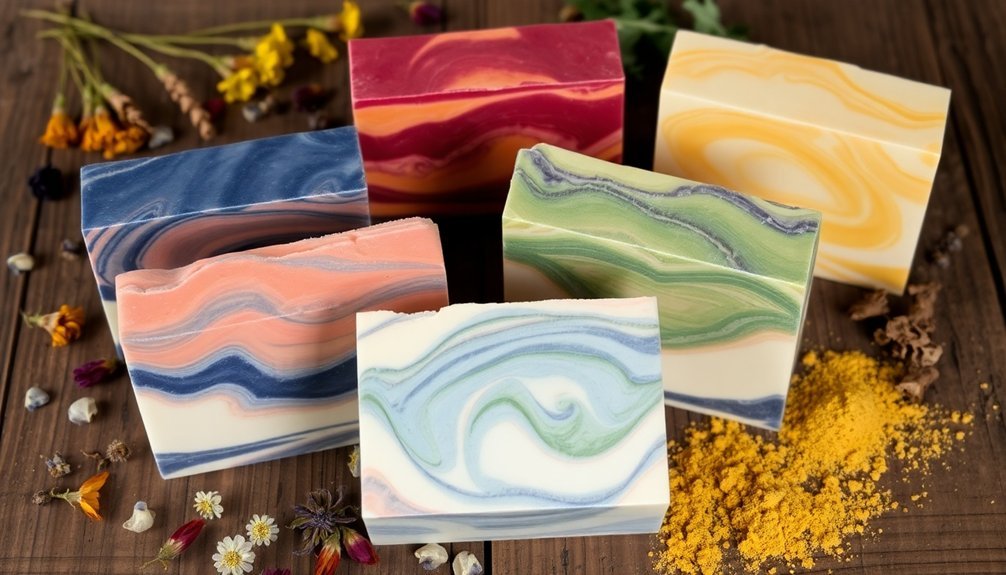
You'll discover endless possibilities when mixing natural plant dyes like madder root and indigo to create your own custom soap colors.
Start by testing small combinations of infused oils and plant powders to understand how different dyes interact and layer within your soap formulation.
Keep detailed notes of successful color ratios to replicate your favorite blends and build a reliable palette of unique natural hues.
Natural Color Mixing Basics
The art of combining plant dyes opens up a vibrant spectrum of possibilities for natural soap coloring. When you're ready to explore natural color mixing basics, start by experimenting with small batches to understand how different plant dyes interact.
You'll find that mixing madder root with turmeric creates striking orange-red hues, while combining indigo with yellow dyes yields rich greens.
Pay attention to pH levels in your soap mixture, as they'll affect your final colors. For instance, alkanet transforms from blue to purple in alkaline conditions.
To achieve consistent custom hues, keep detailed records of your color mixing ratios and results. Remember that the intensity of your final color depends on the proportion of dyes you use, so systematic experimentation is key to developing vibrant color combinations that you can replicate reliably.
Layering Plant Dye Effects
Mastering the art of layering plant dyes can transform your soap-making into a sophisticated color exploration. By combining natural colorants like madder root and turmeric, you'll create unique hues that capture nature's vibrancy.
Start by infusing your oils with plant dyes at a ratio of 1 oz. dye per 15 oz. oil to achieve complex color variations.
You'll want to contemplate how certain plant dyes react during saponification. For example, alkanet's color can shift during the process, so layering it with other dyes helps maintain your desired outcome.
Keep detailed notes of your successful combinations across different soap batches – this practice guarantees you can replicate your favorite results.
Through experimentation with various layering techniques, you'll develop a personal palette that sets your natural soaps apart.
Test Small Batches First
Before scaling up your plant dye combinations, start with small test batches to understand how different natural colorants interact. You'll discover how various plant dyes blend and behave together, allowing you to achieve your desired custom hues without wasting large amounts of materials.
When conducting small batch experiments, keep your colorants at 5% or less of your total soap weight to maintain proper formulation.
You'll notice that plant dyes can produce different results in cold-process soap compared to other methods, so it's essential to test each combination separately. Document your results carefully, noting which combinations work well and which don't meet your expectations.
This documentation will become your reference guide, helping you consistently recreate successful color combinations and avoid unpredictable reactions between different plant dyes in future batches.
Storage and Shelf Life of Natural Colorants
Proper storage of natural colorants plays an essential role in maintaining their vibrancy and effectiveness for soap making.
You'll want to store your colorants in a cool, dark place to preserve their potency and prevent degradation. While dried plant materials can last up to a year in airtight containers, infused oils typically have a shorter shelf life of around six months.
To maximize the shelf life of your natural colorants:
- Check regularly for signs of mold or rancidity, especially in infused oils where moisture can cause spoilage.
- Label and date all storage containers to track freshness and ideal use periods.
- Consider using vacuum sealing or desiccants to minimize moisture exposure and extend storage time.
Frequently Asked Questions
What Are the Natural Dyes From Plants for Soap?
You'll find natural soap dyes in madder root for pink, turmeric for yellow, annatto seeds for orange, and alkanet roots for purple. Don't forget calendula petals, which keep their color well in soap.
Can You Use Regular Food Coloring in Soap Making?
You shouldn't use regular food coloring in soap making. It's not skin-safe, can react unpredictably with lye, and won't maintain stable colors. Instead, opt for natural plant-based or mineral colorants for safe results.
What Herbs Are Good for Coloring Soap?
You'll get beautiful natural colors using madder root for pink-red, turmeric for yellow, alkanet root for purple, annatto seeds for orange, and calendula petals for soft yellow tones in your handmade soaps.
What Is the Best Way to Color Soap?
You'll get the best soap colors by infusing natural plant powders in oil using a 1:15 ratio. Create color-rich batches by using light base oils and ensuring 15% of your total oils contain the infused colorant.
In Summary
Raw plant dyes offer you a natural, sustainable way to color your handmade soaps. You'll reduce your environmental impact while creating unique, earth-friendly products. Whether you're extracting rich browns from coffee grounds, vibrant yellows from turmeric, or soft pinks from rose petals, you're joining a tradition of natural soap crafting. With proper storage and preparation, you'll achieve beautiful, long-lasting colors that you can feel good about using.

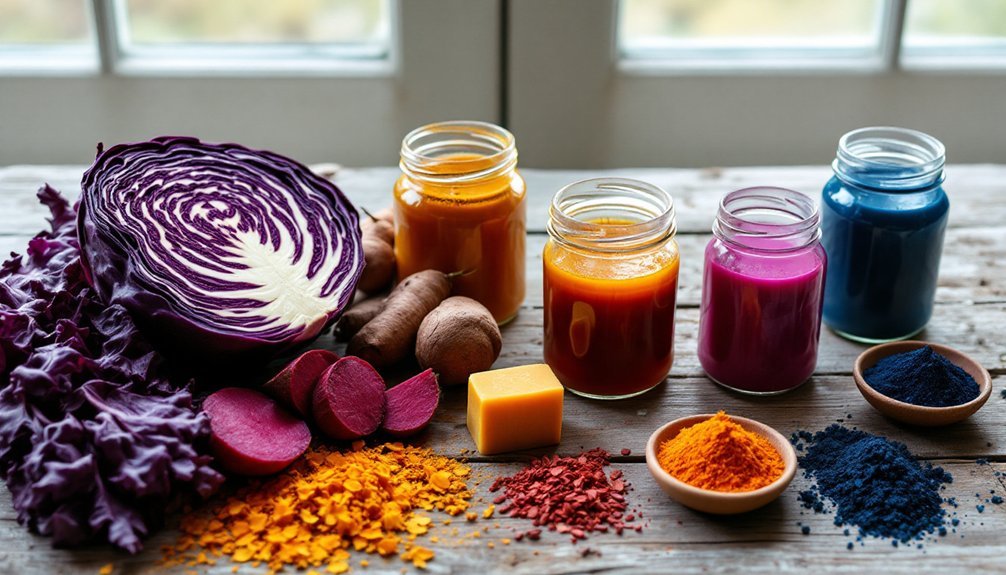



Leave a Reply